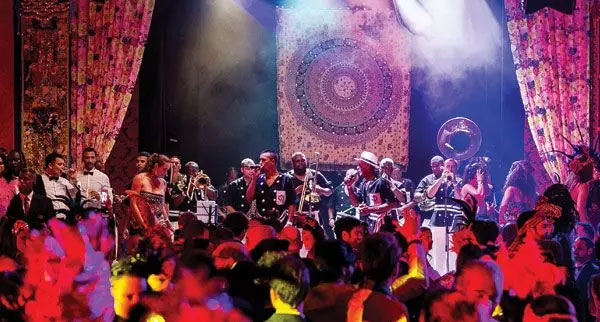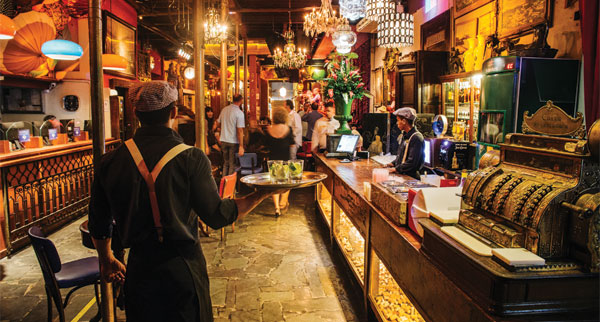Laura French heads to Brazil to experience ‘the greatest party on Earth’, aka Rio Carnival.
Click here to download and save as a PDF.
The samba beat thumps, reverberating through the stadium as the audience bops and bounces along, feet stamping, feathers waving, hands clapping.
It’s hot, humid and deafeningly loud, but the atmosphere is electric: a sea of faces filling the 90,000-capacity Sambadrome that was built for this very purpose.
I’m here on a carnival package with Tucan Travel, and we’re about to watch Rio’s most‑anticipated event of the year: Sunday night’s parades, when six of the city’s elite samba schools compete to be crowned champion.
“Giant gold dragons, Cinderella-like carriages, a huge pink-and-gold Buddha and a turreted castle are among the creations snake their way through.”
Soon the 700-metre runway is a rainbow of colour, split into blocks of gold, green, silver, pink and blue, made up of twirling samba dancers in glittering costumes and extravagant floats the size of double-decker buses. Giant gold dragons, Cinderella-like carriages, a huge pink-and-gold Buddha and a turreted castle are among the creations that snake their way through the first 90-minute parade, as feather-bedecked dancers dangle out the sides, foot movements so rapid my eyes can’t keep up.
Afterwards the second school begins, then the third, then the fourth, and so it goes on for the following seven-plus hours – energy, sparkle and noise ramping up with each procession – until the festivities finally tail off at around 6am. At that point the remaining stragglers go out to enjoy an after-party. Welcome to Rio Carnival.

Carnival balls
I may have been in Rio for only three days, but by this stage I’ve already got used to these rather extraordinary scenes. The previous night I’d found myself at the Belmond Copacabana Palace Ball, the most exclusive carnival event in Brazil, where more than a thousand South American celebrities, politicians and socialites gather to dance samba and feast until 7am.
“Live bands play traditional Brazilian music across a three-floor bar decked out with antiques, and attendees don feathers, masks and glitter.”
Brigitte Bardot, Gerard Butler and Paris Hilton are among those who’ve been on the guest list in previous years, and to say it’s opulent is an understatement: picture lobster, king prawns and macaroons overflowing from huge tables, live bands spilling onto outdoor stages and sequinned floor-length dresses swishing beneath ceilings draped with deep red fabric. I felt like I’d stepped into a scene from The Great Gatsby.
But with prices starting at around £530 per person, it’s not exactly cheap. Fortunately there are plenty of more affordable alternatives, including an annual masquerade at the Rio Scenarium. Here, live bands play traditional Brazilian music across a three-floor bar decked out with antiques, and attendees don feathers, masks and glitter while snacking on traditional Brazilian plates like bolinhos de bacalhau (cod fritters) and beef empanadas (like mini-pasties). It’s a more casual, low‑key affair but it’s still happily authentic, with more locals than tourists, and tickets cost a mere £12.

Street parties
It’s not just the glitzy balls and parades that make up carnival, of course. Just as central to the event are the blocos – moving, sense-overloading street parties where brass bands and vocal groups blast out samba tunes to crowds of up to a million, turning the city into one giant festival for a week.
They’re busy, sweaty and at times a little seedy, so warn clients to be prepared (and advise them to leave valuables at home), but the energy and positivity is hard to beat, with revellers donning all-out fancy-dress costumes that range from feather headdresses to flesh-baring fairies, monkeys to men dressed as bunnies – and a whole lot of drag.
“My favourite was Banda da Ipanema, which had us bopping our way past the beach among a crowd of 90,000, singing and clapping along to classic samba songs.”
More than 400 blocos take place across the city, with annual highlights including Carmelitas, themed around nuns and devils, Cordão do Bola Preta, where everyone dresses in polka dot, and Sargento Pimenta, where a samba band plays Beatles tunes with a Brazilian twist. My favourite was Banda da Ipanema, which had us bopping our way past the beach among a crowd of 90,000, singing and clapping along to classic samba songs like there was no tomorrow, sun streaming down on our faces, caipirinhas firmly in hand.
Catching them at the right place and time involves a bit of planning, so suggest clients do some research first – though wherever they head they’ll likely find a party of some kind, with pop-up stages scattered across the city and Lapa’s main square and bars bursting day and night.

Beyond the festivities
Even during carnival season, Rio isn’t just about the partying, with plenty of sights to see beyond the fiesta. Among the standouts for me was Christ the Redeemer, the 30m-tall statue which towers over the city from the peak of Corcovado hill, a reminder that Brazil is home to the biggest Catholic population in the world.
“Most memorable was a visit to Lapa’s Selarón Steps, an outdoor ascent covered in brightly coloured mosaic tiles, created by Chilean artist Jorge Selarón.”
Equally impressive was Sugarloaf Mountain, the soaring rock which juts up into the sky. Cable cars whizz visitors to the top, with 360-degree views of mist-covered mountains rising in ripples from a bed of green foliage.
But most memorable was a visit to Lapa’s Selarón Steps, an outdoor ascent covered in brightly coloured mosaic tiles, created by Chilean artist Jorge Selarón as a “tribute to the Brazilian people”.

As we climbed its ceramic slope we were treated to a mini samba performance by three locals playing drums, including a 10-year-old boy prancing around with the rapidity and precision only a Brazilian could pull off. It was an impromptu, energetic spectacle that echoed the sheer vivacity (and talent) seen at the Sambadrome – and an apt image for the carnival as a whole.
These steps are a place where people from all walks of life gather: locals from the favelas, where samba originated in the early 20th century; musicians from Santa Teresa, the bohemian neighbourhood nearby; and tourists from across the world, who come to witness this unique celebration.
“As we climbed its ceramic slope we were treated to a mini samba performance by three locals playing drums, including a 10-year-old boy prancing around.”
That sense of bringing people together is exactly what Rio Carnival is about. Every part of society is represented in one way or another here, and from hectic bloco to high‑society ball, extravagant parade to street-side performance, you’ll find something to suit anyone who’s up for letting their hair down for a week of all-out, anything-goes escapism.
Book it: Tucan Travel’s five-night Rio Carnival City Experience costs from £759, including twin-share hotel accommodation with breakfast, orientation walk and dinner, city tour and sector 11 Sambadrome ticket. Flights are extra.
tucantravel.com
How to sell
Book a package so guests have a guide on hand to provide advice on the best blocos and where to find them, plus guaranteed accommodation during Rio’s busiest season. A group also makes it a sociable option for solo travellers, and creates even more atmosphere while cheering along at the Sambadrome.

Carnival facts
1. The five-day fiesta officially begins on the Friday before Ash Wednesday and finishes on the Tuesday – but it actually goes on for more than a week.
2. The 2019 Rio Carnival runs from March 1-6.
3. More than 30,000 people take part in the Sambadrome parades, spread across four nights. Sunday and Monday showcase the city’s elite ‘Special Group’ schools, while Friday and Saturday are the ‘Access Group’ parades for those a level down.
4. Carnival is said to have originated in Greece around 520BC as a thanksgiving to the gods, and was later a day of revelry for the Romans. It was brought to Brazil by the Portuguese in the 18th century.
Read more
How to spend a weekend in Rio de Janeiro, Brazil
Discover Paraty, Rio de Janeiro’s best kept secret
Lesser-known vibrant festivals in Latin America




